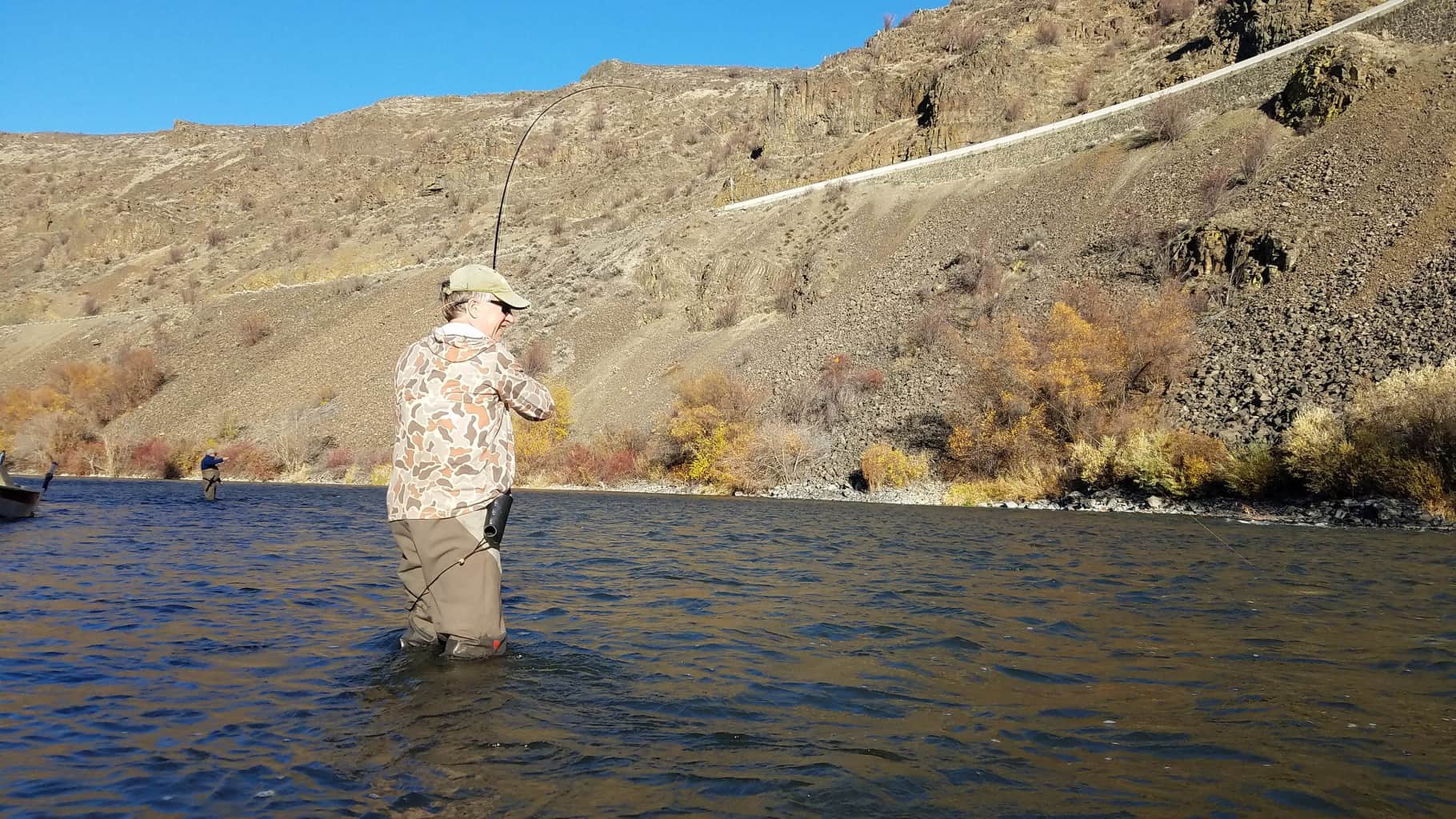The Yakima River offers the best stream trout fishing in Washington, and honestly that’s not really up for debate.
It’s a classic Western stream, reminiscent of what you might find in Montana or elsewhere in open country: wide, best fished by boat, and a joy to experience.
While trout fishing (and especially fly fishing) is what brings the Yakima River its fame, the lower and slower sections of the lower river offer impressive angling for warmwater fishing, especially smallmouth bass and channel catfish.
In years of abundance, spring Chinook salmon also can be caught in lower sections of the river.
We’ll discuss those lower river fishing opportunities later in this article, but first to the main show: Trout fishing.
Fly fishing is especially popular here, and fly anglers travel from all over the country – and, in rare cases, the world – for a shot at chasing trout on the Yakima.
The river is a tailwater, too, which means it’s productive for trout all year.
In fact, the Yakima River was an easy choice for our run-down of the best fly fishing rivers in Washington.
The fish aren’t the biggest trout in the country, but they are numerous, and the average fish on the river falls between the 13 and 16 inch range.
If you’re thinking about fishing the Yakima, you’re not alone. It’s a popular river.
Emerald Water Anglers, a premier guide shop, claims the reason the Yakima has such acclaim and popularity is that it’s “really the only year-round dedicated fly fishing/artificial lure river…in the state of Washington.”
The special management of the Yakima by the Washington Department of Fish and Wildlife (WDFW) coupled with its stellar year-round fishing makes it a dream destination for any fly fishermen, and it’s without a doubt the best trout fly fishing river in Washington.
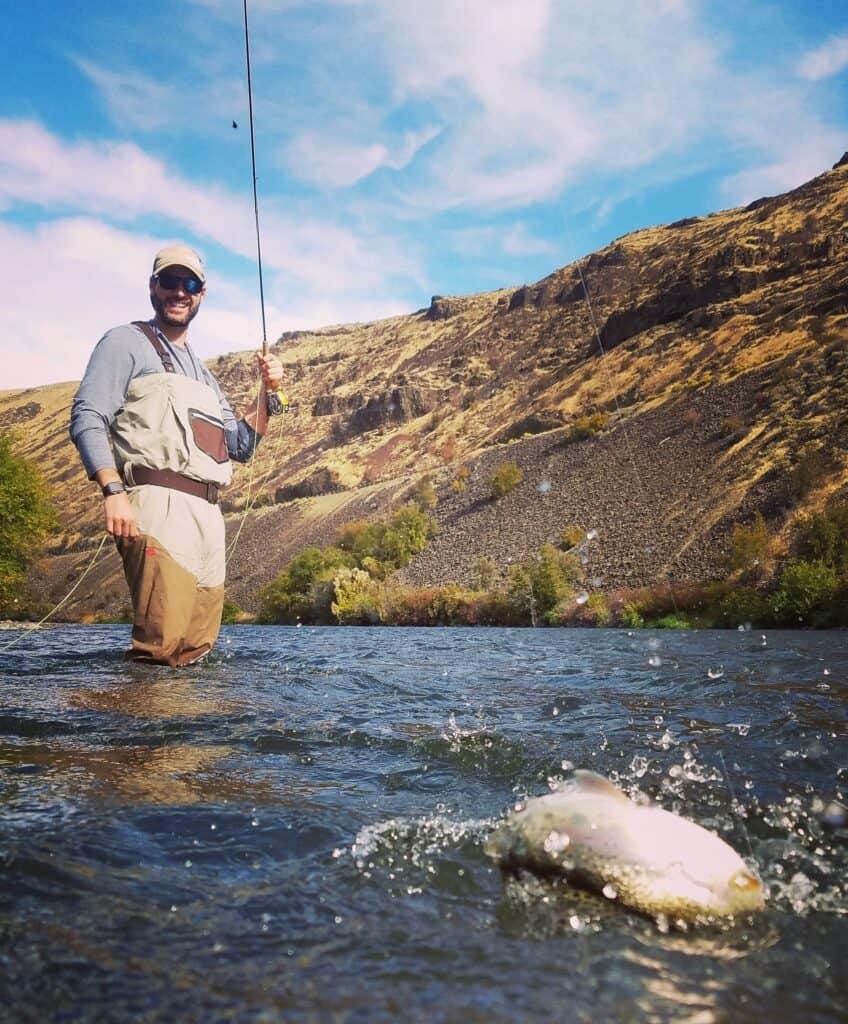
The Yakima River also offers some other angling options as well, notably salmon and smallmouth bass fishing opportunities in the lower river, closer to the Columbia River.
When to Fish
The beauty of a well-managed tailwater like the Yakima is that these types of rivers generally fish well year-round, and the Yakima is no exception.
Each season brings with it new challenges and opportunities.
Early spring through midsummer provide tremendous dry fly action (which returns promptly in the fall), the dog days of summer are great hopper weather, and the winter is primarily a nymphing game.
In short? There’s no bad time to fish the Yakima for trout.
Let’s go over each trout-fishing season on the river in a little bit more detail.
Fishing the Yakima in Spring
Starting around late February, dry fly action begins to pick up on the Yakima.
This is, yet again, one of the benefits of a tailwater fishery – dry fly hatches happen earlier in the season than you’d expect otherwise.
Skwalas, a type of stonefly, and blue winged olives dominate the hatch cycle for most of the spring, and you can expect some fast and furious action when the fishing is on.
Dry fly fishing tapers off between around mid-June, when river flows are significantly elevated to allow for irrigation in the region. But, from February to June, the Yakima is a standout dry fly fishery.
Fishing the Yakima in Summer
Fishing wide open water on a warm summer day is the idyllic fly fishing experience, and the Yakima certainly fits the bill.
Summer is one of the best seasons to fish the Yakima, and there are a wide variety of opportunities available.
In the early summer, as mentioned previously, flows can be quite high. This means two things: floating the river (rather than walking and wading) is the way to go, and nymphing is primarily the game until the water levels go down.
Once the flows do go down later in the summer, which tends to happen around late August or September most years, there is a brief hopper season on the river.
Maybe it’s not the best hopper season in the world (don’t be expecting Montana-esque action), but it can be very productive.
Fishing the Yakima in Fall
As the fall progresses and October and November roll around the corner, the summer hopper season dies down but dry fly fishing is still excellent through mid-November.
The Yakima is a high-desert stream, so weather can take a significant turn for the worse starting around mid-October.
Cold temperatures often can drive anglers away from the river, which means you should find plenty of river to yourself if you fish the Yakima during the late fall or the winter.
Fishing the Yakima in Winter
Winter on the Yakima means an end to most significant dry fly action, but that doesn’t mean that there aren’t fish to be had.
Nymphing is the game in the winter, and winter flows are typically much lower than the rest of the season – this means that if you’re a hardy walk-and-wade angler, winter is the time to go.
Winter’s also a great time to check out the Yakima if you’re seeking solitude, as the often harsh weather conditions keep most people away from the river during the colder months of the year.
Trout Fishing
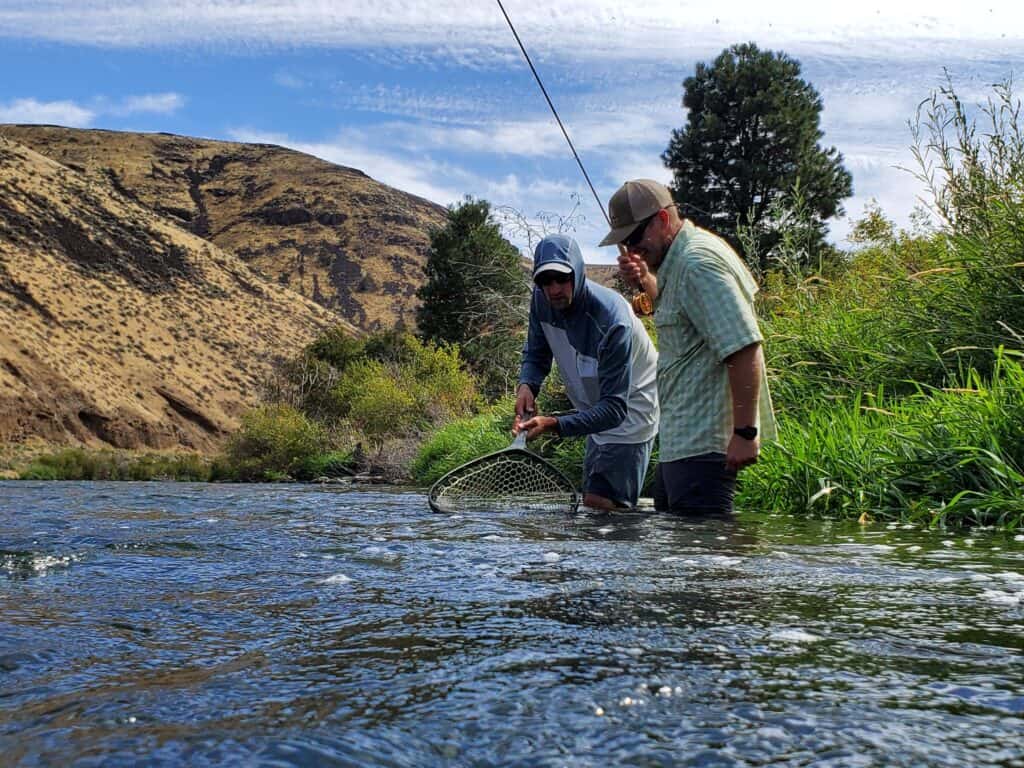
Two types of trout are present in the Yakima River: rainbow trout and westslope cutthroat trout.
Rainbows are by far the predominant species, and the westslope cutthroat mainly reside in the lightly fished upper stretches of the river.
This is a big river that holds trout up to 25 inches (and, in some cases, even bigger), so you want to make sure you have a stout rod.
If you’re dry fly fishing or traditional nymphing, five and six-weight fly rods are the way to go.
If you’re euro nymphing, you might want to ditch the zero or one-weight fly rods – they can be great on smaller streams, but the force of the Yakima’s current coupled with the size of the fish could put too much of a strain on a light rod.
A three-weight rod is perfect if you’re euro nymphing.
Best Fly Patterns for Yakima River Trout
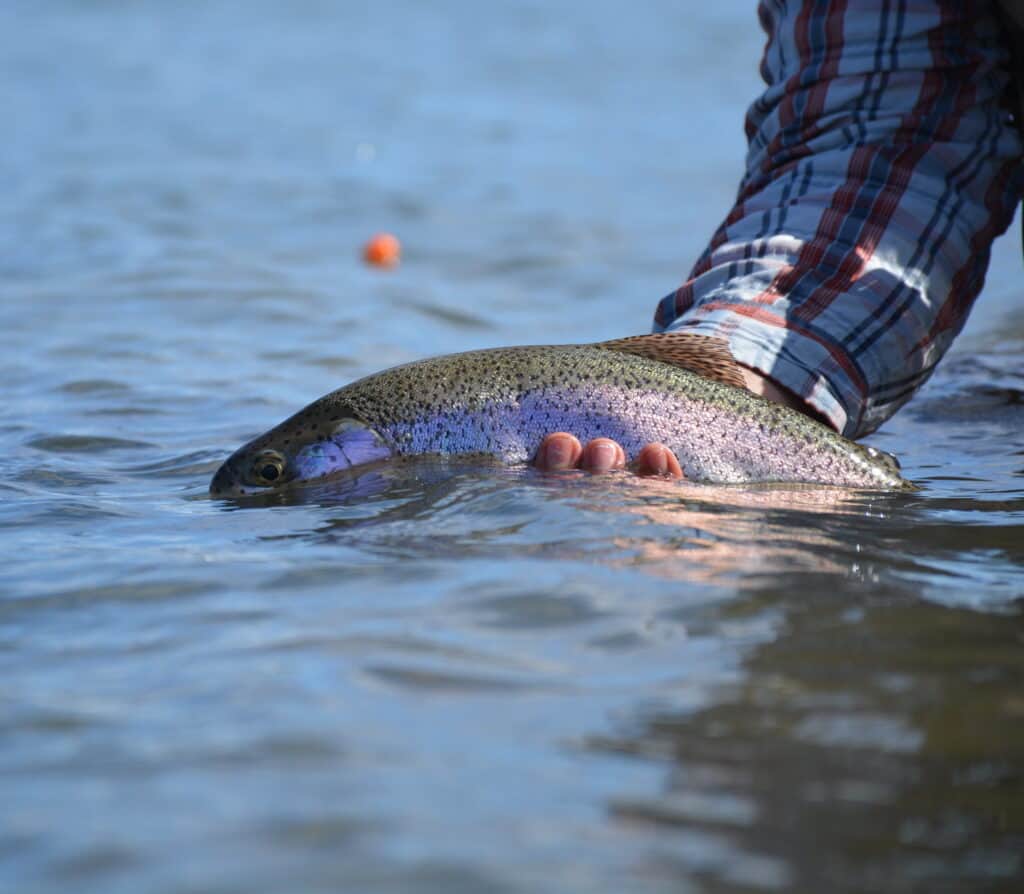
All sorts of patterns work well on the Yakima, but here are a primary few to consider:
Nymphing: Stonefly patterns, pheasant tails, hare’s ears, zebra midges, perdigons, frenchies.
Dry flies: BWO patterns, skwala patterns, hoppers, midges, various emergers.
That’s a really general list, but it should give you an idea of what to stock up on before you head out to the Yakima.
The trout here are not normally incredibly picky, but matching the insects hatching in the river will boost your chances tremendously.
Best Yakima River Trout Fishing Spots
The Yakima can be divided in many ways, but for focusing on trout fishing we’ll break it down into three sections: the Upper Yakima, the Middle Yakima, and the Lower Yakima.
The most popular stretch of the Yakima is between Easton and Roza dams. However, that’s a very long stretch of water – nearly 100 miles, and there’s a lot of water to cover.
This stretch of the Yakima is likely where you’ll be trout fishing, and we can divide this stretch into the Upper and Middle Yakima.
Fishing the Upper Yakima River
Most anglers consider the Upper Yakima river to be from Easton Dam downstream to Thorp, as this is essentially the upper half of the stretch between Easton and Roza dams.
This stretch of the river isn’t as popular as lower down, but there is productive fishing for rainbows and cutthroat to be had.
The Worley Bugger Fly Co. provides a good map of access points and put-ins.
This stretch is more lightly pressured than the river below Thorp, so if you’re looking to escape the crowds, then this is a good spot to check out.
Fishing the Middle Yakima River
The Middle Yakima flows from Thorp down to Roza Dam, and the most popular water here is downstream of Ellensburg.
This is the premier stretch of water on the Yakima; if you’re taking a guided float trip, this is likely where you’ll go.
Expansive water and thousands of big trout await, so if you want the classic Yakima experience, head to this stretch of the river!
Fishing the Lower Yakima River
Below Roza Dam, fly fishing interest drops off dramatically.
As the river winds its way toward Yakima, about 13 miles downstream, it becomes warmer and more sluggish, becoming more of a smallmouth bass river than a trout river.
However, if you can get access, the first few miles below Roza Dam are great if you’re looking to catch some big trout.
This is a fairly lightly fished stretch as well, so you may likely find more solitude here than those middle sections of the river.
Warmwater Fishing on the Lower Yakima River
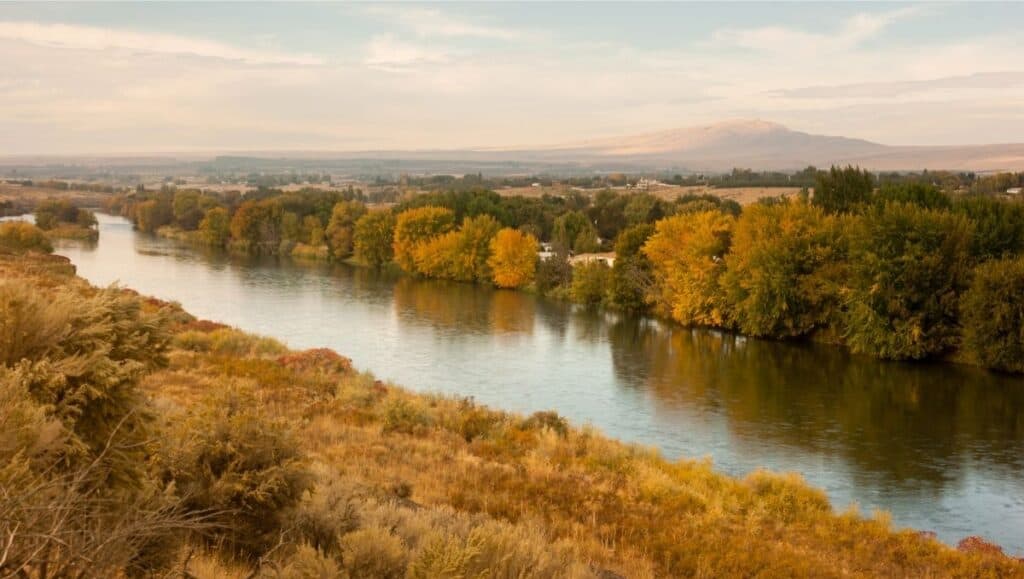
For this type of fishing, we’re talking about well downstream of the areas discussed in the trout-fishing sections of this article.
The best warmwater angling is in the lowest 50 miles or so of the river, roughly from Granger down to where the Yakima River flows through Richland and into the Columbia at the Tri-Cities.
Bass Fishing
In the lowest reaches of the Yakima, smallmouth bass are not only plentiful, they can grow to impressive sizes.
Smallmouth bass are abundant throughout this region, present in large numbers in the Columbia, Snake and other rivers as well as many reservoirs and lakes. The region is well-represented among the best smallmouth bass fishing lakes and rivers in Washington.
In the Yakima you can find them in pools, behind rocks and even in moderate current, although they typically like to be somewhere where they can easily ambush passing prey such as smaller fish and crayfish.
Sometimes larger smallmouth bass will move into the lower few miles of the Yakima River, especially during the early spring, so that’s often a good time to catch larger specimens, though perhaps not the numbers of fish you’ll catch in the summer.
There also are a modest number of largemouth bass in the system. Largemouth aren’t as current-oriented as smallmouth so look for them where you find quieter water.
Unlike the trout, bass don’t get a ton of attention on the Yakima, but they are strong fighters and are sure to provide plenty of action during warmer weather.
Both species of bass readily hit soft plastic grubs and other lures, crankbaits, spinners and even artificial flies that imitate some of their food sources.
Catfish Fishing
Channel catfish are the primary focus of catfish anglers in the Yakima River.
These are tasty fish that grow to impressive sizes in this region’s lower river sections.
To catch catfish, try using fresh bait such as nightcrawlers, cut bait such as fish parts, and shrimp or prawns. Prepared “stink bait” doughs also will work.
Try fishing in some of the deeper pools where the current brings food down toward hungry cats, especially during brighter light conditions.
Catfish will feed most aggressively in lower light conditions and may come into shallower water at these times.
Catfish can be caught all year, but fishing is most productive as the water warms in spring and especially in summer and early fall.
We’ve included the lower Yakima River in our listing of the best catfish fishing spots in Washington.
Salmon Fishing
At times, the spring Chinook salmon runs into the Yakima River have been good enough that the Washington Department of Fish & Wildlife has opened parts of the river to salmon fishing.
This is a very regulated fishery that is closed under annual regulations and only opened when the runs of hatchery-produced springers justify a recreational harvest.
If it does open, WDFW posts regulation updates on its website, so it’s always advisable to read up on the latest.
They will designate specific areas of the river where salmon fishing becomes legal, typically defining legal sections within the broader 100 or so river miles from Roza Dam to the confluence with the Columbia River at Richland.
This fishery would likely begin sometime in May and continue into early summer, or whenever WDFW decides to close it.
Typically, WDFW allows bait-fishing in this fishery, which often is the most effective way to catch spring Chinook salmon. Roe and shrimp are good baits.
Artificial lures such as wobbling plugs (often wrapped with bait such baitfish fillets) or spinners also can be effective ways to catch salmon.
Steelhead have faced tougher times on the Yakima for many years, and at this time fishing for them is not permitted on the mainstem. They do pass through the river on their way to tributaries such as the Naches.
Conclusion
All in all, the Yakima River is a gem.
It’s not just a river that’s popular with the locals, but it’s a Pacific Northwest icon.
If you get the chance to take a trip up to the Yakima, take advantage of it and go! You won’t be disappointed.
Find more fishing spots in Kittitas County
Find more fishing spots in Yakima County
Carter Reschke is a freelance writer based in Oregon. Passionate about the outdoors, Carter is a fly fishing aficionado and spends his days on the river when he’s not writing.

